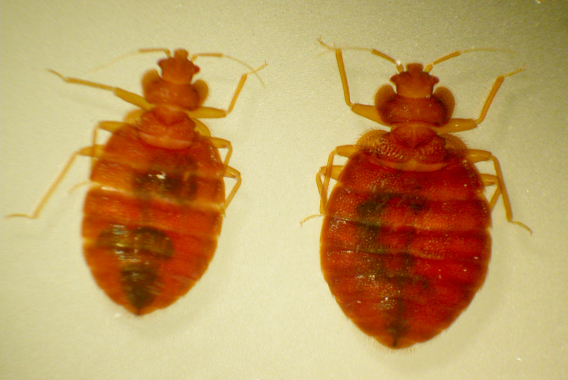Cimex lectularius
Common bed bug
Synonym(s): Human bed bug, bedbug
Class: Hexapoda
Order: Hemiptera
Family: Cimicidae

Photographer: http://www.pestproducts.com/images/bedbugs.jpg
Source: http://www.pestproducts.com/images/bedbugs.jpg
Description
Adult Description: The adult common Bedbug (Cimex lectularius) is red/brown in color, oval in its overall shape, dorsoneutrally flattened, and is 5.5 mm in length. The forewings are broad and rectangular in shape. Short stiff hairs are present on the prothorax (near the first pair of legs) that are shorter than the length of the insect's eye.
Larva Description: The Common Bedbug larva is similar in appearance to the adult with a noticeable difference in color. In the nymph or larval stage the body of the Common Bedbug is lighter in color. There are five larval stages which require feeding on blood in between stages and molting to allow for an increase in size. The eggs are white and measure about 1mm in length. The first larval stage produces a larvae of 1.5mm in length which increases proportionally through each stage resulting in a 5.5mm adult.
Host Plant: The Common Bedbug doesn't utilize a host plant, it is known for seeking human hosts.
Ecological Threat: The Common Bedbug is known to carry over 40 diseases in the form of blood-born pathogens. However, they are not known to transmit diseases to humans but are known for causing irritation and swelling around the area of the bite.
Biology: The Common Bedbug has a relatively long life cycle of 6-12 months, they are able to sustain life without nutrients from a host for a long period of time enabling them to go undetected.
History: It is thought that the Common Bedbug was brought to North America with early settlers and has since then spread throughout.
U.S. Habitat: The Common Bedbug can be found on or near hosts human where adults and larvae can take blood meals.
Distribution
Native Origin: Europe
U.S. Present: The Common Bedbug can be found readily throughout the United States.
Resembles/Alternatives
Common Bedbugs are similar to two other bedbugs in the genus Cimex, Cimex hemipterus and Cimex adjunctus. Cimex hemipterus differs from Cimex lectularius in that it is less laterally expanded and less flattened. Cimex adjunctus has longer hair on the prothorax comparatively to Cimex lectularius.
Management
Cimex lectularius has no known parasites that can be used for control. However C. lectularius populations are limited by temperature fluctuations. Currently, research tests for effective pesticides have shown pesticide containing Cyhalothrin to be the most effective. Unfortunately, in the study strains of C. lectularius were found to be resistant to this treatment in comparison to strains taken from the natural environment.
SEARCH Online
Google Search: Cimex lectularius
Google Images: Cimex lectularius
NatureServe Explorer: Cimex lectularius
Bugwood Network Images: Cimex lectularius
References
Ryckman, R.E., D.G. Bently, and E.F. Archbold. 1981. The Cimicidae of the Americas and Oceanic Islands, a checklist and bibliography. Bull. Soc. Vector. Ecol. 6:93-142.
Johnson, C.G. 1941. The Ecology of the Bed-Bug, Cimex lectularius L., in Britain: Report on Research, 1935-40. Journal of Hygiene, 41(4):45-461.
Internet Sources
http://bugguide.net/node/view/15475
http://www.itis.gov/servlet/SingleRpt/SingleRpt
http://www.ncbi.nlm.nih.gov/pmc/articles/PMC2957946/
 Texas Invasive Species Institute
Texas Invasive Species Institute